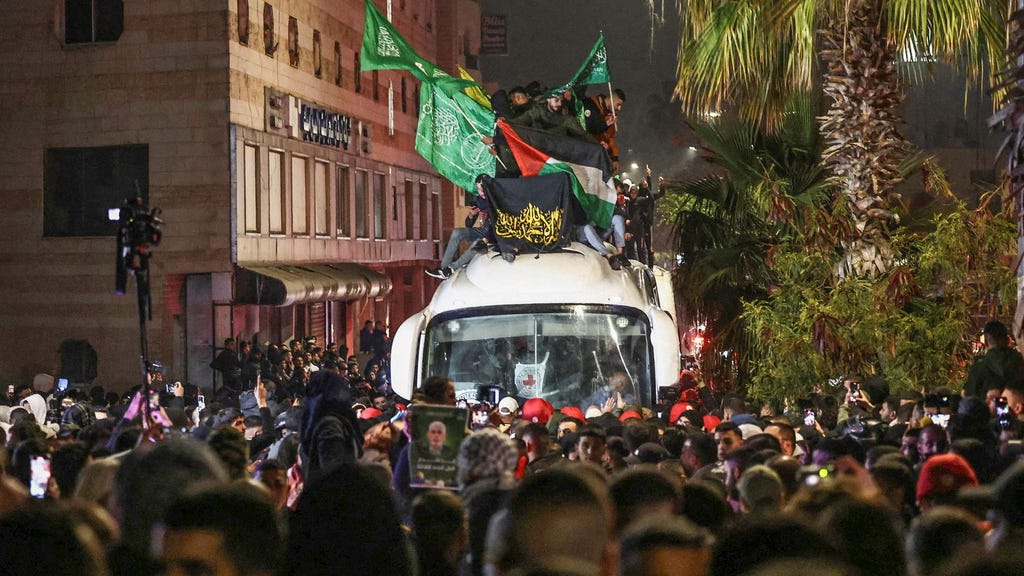The First Wave of Freedom: A Fragile Truce Emerges in the Israel-Hamas Conflict
The scenes in Beitunia were a mix of jubilation and trepidation. Two buses, carrying the first wave of Palestinian prisoners released as part of a fragile ceasefire agreement with Hamas, were met by cheering crowds waving Palestinian and Hamas flags. Sixty-two women and 28 men, including nine minors, mostly residents of the West Bank, disembarked, their faces a mixture of relief and apprehension. Information about the individual identities of the released prisoners remained scarce, adding to the sense of uncertainty. Around ten of the freed individuals were expected to return to their homes in East Jerusalem. Importantly, according to Israeli sources, none of the prisoners released in this initial phase were convicted of murder. This carefully orchestrated release marked the first tangible step in a complex and fraught ceasefire arrangement aimed at ending the latest cycle of violence between Israel and Hamas. While the release brought joy to families and supporters, the underlying tensions remained palpable, underscoring the fragility of the truce.
This first release was directly linked to the freedom regained by three Israeli hostages – Romi Gonen, Doron Steinbrecher, and Emily Damari. Hamas released these captives earlier on Sunday, allowing them to reunite with their families. Their release was a key component of the negotiated ceasefire, a precursor to the larger prisoner exchange that is expected to unfold over the coming weeks. The exchange highlights the intricate human element at the heart of the conflict, where individuals become bargaining chips in a larger geopolitical game. While the reunions brought moments of intense emotion and relief, they also served as a stark reminder of the heavy price paid by civilians caught in the crossfire.
Even as celebrations unfolded, shadows of the ongoing conflict lingered. Following the prisoner release, reports surfaced of Israeli settlers attacking Palestinian villages in the West Bank. Stone-throwing and firebomb attacks were reported in Turmusaya and several other villages. These actions, interpreted as protests against the ceasefire agreement, underscored the deep divisions and simmering anger that continue to fuel the cycle of violence. The attacks served as a stark reminder of the challenges ahead in implementing and maintaining the ceasefire, particularly given the deep-seated mistrust and animosity between the two sides.
The ceasefire agreement, while tenuous, brought a temporary respite to the besieged Gaza Strip. The truce allowed Palestinians to return to their devastated neighborhoods and begin the arduous process of rebuilding. More than 630 trucks loaded with humanitarian aid were permitted to enter Gaza, offering a lifeline to the beleaguered population. For many, the arrival of aid marked the first glimmer of hope after months of relentless bombardment and deprivation. The ceasefire, albeit temporary, offered a crucial window for aid agencies to deliver essential supplies and provide much-needed support to the traumatized population.
The human cost of the conflict has been staggering. According to the Hamas-run health ministry in Gaza, over 47,000 Palestinians have been killed since the start of the war. The overwhelming majority of Gaza’s 2.3 million residents are now homeless, displaced by the relentless bombardments that have flattened entire neighborhoods. The scale of destruction is immense, with homes, hospitals, and essential infrastructure reduced to rubble. The ceasefire provides a critical opportunity to assess the full extent of the damage and begin the long and challenging process of recovery and reconstruction. However, the sheer magnitude of the devastation underscores the immense challenges ahead in rebuilding lives and communities shattered by the conflict.
The ceasefire agreement outlines a phased approach to prisoner releases and humanitarian aid delivery. In the initial phase, which commenced on Sunday, 33 of the remaining Israeli hostages are expected to be released over a six-week period. However, the fate of many hostages remains uncertain, with fears that some may not be alive. In exchange for the release of these hostages, approximately 2,000 Palestinian prisoners are slated for release. The prisoner exchange represents a delicate balancing act, a crucial element in building trust and securing a more lasting peace. However, the complexities surrounding the identities and conditions of the hostages and prisoners add another layer of difficulty to an already precarious situation. The success of the ceasefire hinges on the meticulous implementation of these arrangements and the ongoing commitment of both sides to de-escalation and dialogue.














